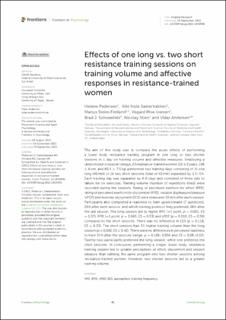| dc.contributor.author | Pedersen, Helene | |
| dc.contributor.author | Sæterbakken, Atle Hole | |
| dc.contributor.author | Fimland, Marius Steiro | |
| dc.contributor.author | Iversen, Vegard Moe | |
| dc.contributor.author | Schoenfeld, Brad J | |
| dc.contributor.author | Stien, Nicolay | |
| dc.contributor.author | Andersen, Vidar | |
| dc.date.accessioned | 2022-10-06T09:33:55Z | |
| dc.date.available | 2022-10-06T09:33:55Z | |
| dc.date.created | 2022-09-29T10:42:52Z | |
| dc.date.issued | 2022 | |
| dc.identifier.citation | Pedersen, H., Saeterbakken, A. H., Fimland, M. S., Iversen, V. M., Schoenfeld, B. J., Stien, N., & Andersen, V. (2022). Effects of one long vs. two short resistance training sessions on training volume and affective responses in resistance-trained women. Frontiers in Psychology, 13:1010596. | en_US |
| dc.identifier.issn | 1664-1078 | |
| dc.identifier.uri | https://hdl.handle.net/11250/3024258 | |
| dc.description.abstract | The aim of this study was to compare the acute effects of performing a lower body resistance training program in one long or two shorter sessions in 1 day on training volume and affective measures. Employing a randomized-crossover design, 23 resistance-trained women (22 ± 2 years, 166 ± 6 cm, and 66.4 ± 7.5 kg) performed two training days consisting of (i) one long (46 min) or (ii) two short sessions (total of 43 min) separated by 3.5–5 h. Each training day was separated by 4-6 days and consisted of three sets to failure for six exercises. Training volume (number of repetitions lifted) were recorded during the sessions. Rating of perceived exertion for effort (RPE), rating of perceived exertion for discomfort (RPD), session displeasure/pleasure (sPDF) and exercise enjoyment (EES) were measured 10 min after each session. Participants also completed a readiness to train questionnaire (7 questions), 24 h after each session, and which training protocol they preferred, 48 h after the last session. The long session led to higher RPE (+1 point, p < 0.001, ES = 1.07), RPD (+1 point, p = 0.043, ES = 0.53) and sPDF (p = 0.010, ES = 0.59) compared to the short sessions. There was no difference in EES (p = 0.118, ES = 0.33). The short sessions had 3% higher training volume than the long session (p = 0.002, ES = 0.42). There were no differences in perceived readiness to train 24 h after the sessions (range: p = 0.166–0.856 and ES = 0.08–0.32). Twenty-two participants preferred the long session, while one preferred the short sessions. In conclusion, performing a longer, lower body, resistance training session led to greater perceptions of effort, discomfort and session pleasure than splitting the same program into two shorter sessions among resistance-trained women. However, two shorter sessions led to a greater training volume. | en_US |
| dc.language.iso | eng | en_US |
| dc.publisher | Frontiers Media | en_US |
| dc.rights | Navngivelse 4.0 Internasjonal | * |
| dc.rights.uri | http://creativecommons.org/licenses/by/4.0/deed.no | * |
| dc.title | Effects of one long vs. two short resistance training sessions on training volume and affective responses in resistance-trained women | en_US |
| dc.type | Peer reviewed | en_US |
| dc.type | Journal article | en_US |
| dc.description.version | publishedVersion | en_US |
| dc.rights.holder | © 2022 Pedersen, Saeterbakken, Fimland, Iversen, Schoenfeld, Stien and Andersen. | en_US |
| dc.source.volume | 13 | en_US |
| dc.source.journal | Frontiers in Psychology | en_US |
| dc.identifier.doi | 10.3389/fpsyg.2022.1010596 | |
| dc.identifier.cristin | 2056761 | |
| dc.source.articlenumber | 1010596 | en_US |
| cristin.ispublished | true | |
| cristin.fulltext | original | |
| cristin.qualitycode | 1 | |

